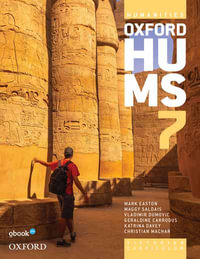
A History of the Ancient Near East ca. 3000 - 323 BC
Paperback | 20 September 2024 | Edition Number 4
At a Glance
400 Pages
25.5 x 18.0 x 2.2
Paperback
RRP $75.95
$50.90
33%OFF
or 4 interest-free payments of $12.72 with
orAims to ship in 7 to 10 business days
The latest edition of the bestselling introduction to the rich and complex history of the ancient Near Eastern world, with new historical data and evidence throughout
A History of the Ancient Near East presents a comprehensive overview of the extraordinary multicultural civilizations of the region. Surveying three millennia of Near Eastern history in a single volume, this classroom-proven textbook explores the origins of the first cities in Mesopotamia, the growth of the Babylonian and Hittite kingdoms, and the rise of the Assyrian and Persian empires. Concise, student-friendly chapters guide readers through major historical events and a wide variety of political, social, and cultural developments, beginning from the invention of writing circa 3000 BC and ending with the conquests of Alexander the Great.
Incorporating the latest research in the rapidly developing field, the fourth edition of A History of the Ancient Near East contains entirely new sections on new archaeological discoveries and textual findings. Streamlined and improved chapters-based on feedback from undergraduate students, reviewers, and lecturers with direct teaching experience with the textbook-are supported by new date maps and images, additional "Key Debate" boxes, and a fully up-to-date bibliography.
Presented in an easy-to-understand narrative style, A History of the Ancient Near East:
- Explores recent discoveries that have shaped current discourse on the Ancient Near East
- Highlights the strengths and limitations of the original sources cited in the text
- Offers in-depth yet accessible coverage of key texts and sources, including the Bible and the Epic of Gilgamesh
- Discusses differing interpretations of the causes of the collapse of the Bronze Age
- Engages students with various perspectives on critical issues, such as why people moved into cities
- Contains detailed maps, historical timelines, images and illustrations, and an extensive bibliography
Integrating primary sources, contemporary scholarship, and a wealth of supplementary materials, A History of the Ancient Near East ca. 3000-323 BC, Fourth Edition, remains an essential resource for undergraduate and introductory graduate students taking courses on archaeology or ancient Near Eastern history, as well as general readers with an interest in the ancient world and the Bible.
Industry Reviews
"This marvelous book is a classic, and deservedly so. In his clear and fascinating narrative, Van De Mieroop lays out the political history of the ancient Near East, while also including extensive quotes from ancient sources, overviews of important scholarly debates, and well-chosen illustrations, charts, tables, and maps. This new edition brings the history up to date with revelations from newly published cuneiform tablets and recent archaeological excavations. My students always find much to discuss in the pages of this book, and it also receives high praise from general readers interested in the deep and influential past of the Middle East."
—Amanda H. Podany, Professor of History, Cal Poly Pomona
"An outstanding resource for studying the history of the ANE... It is remarkable to find a volume with this subject matter that is as clear and as engaging as what Van De Mieroop has offered here."
—Kurtis Peters, RBECS
List of Illustrations x
List of Charts xiii
List of Maps xiv
List of Debates xv
List of Boxes xvi
List of Documents xvii
Preface xix
Author’s Note xxii
1 Introductory Concerns 1
1.1 What Is the Ancient Near East? 1
1.2 The Sources 4
1.3 Geography 5
1.4 Prehistoric Developments 9
Part I City-States 19
2 Origins: The Uruk Phenomenon 21
2.1 The Origins of Cities 22
2.2 The Development of Writing and Administration 29
2.3 The “Uruk Expansion” 37
2.4 Uruk’s Aftermath 39
3 Competing City-States: The Early Dynastic Period 41
3.1 The Written Sources and Their Historical Uses 42
3.2 Political Developments in Southern Mesopotamia 45
3.3 Warfare and Political Centralization 48
3.4 The Wider Near East 52
3.5 Early Dynastic Society 55
3.6 Scribal Culture 58
4 Political Centralization in the Late Third Millennium 63
4.1 The Kings of Akkad 64
4.2 The Third Dynasty of Ur 74
5 The Near East in the Early Second Millennium 85
5.1 Nomads and Sedentary People 86
5.2 Babylonia 90
5.3 Assyria and the East 94
5.4 Mari and the West 100
6 The Growth of Territorial States in the Early Second Millennium 106
6.1 Shamshi-Adad and the Kingdom of Upper Mesopotamia 108
6.2 Hammurabi’s Babylon 111
6.3 The Old Hittite Kingdom 120
6.4 The “Dark Age” 123
Part II Territorial States 127
7 The Club of the Great Powers 129
7.1 The Political System 131
7.2 Political Interactions: Diplomacy and Trade 134
7.3 Regional Competition: Warfare 141
7.4 Shared Ideologies and Social Organizations 143
8 The Western States of the Late Second Millennium 149
8.1 Mittani 150
8.2 The Hittite New Kingdom 155
8.3 Syria-Palestine 163
9 Kassites, Assyrians, and Elamites 171
9.1 Babylonia 172
9.2 Assyria 178
9.3 The Middle Elamite Kingdom 184
10 The Collapse of the Regional System and Its Aftermath 189
10.1 The Events 190
10.2 Interpretation 196
10.3 The Aftermath 198
Part III Empires 207
11 The Near East at the Start of the First Millennium 209
11.1 The Eastern States 210
11.2 The West 218
12 The Rise of Assyria 230
12.1 Patterns of Assyrian Imperialism 231
12.2 The Historical Record 238
12.3 Ninth-Century Expansion 240
12.4 Internal Assyrian Decline 244
13 Assyria’s World Domination 248
13.1 The Creation of an Imperial Structure 249
13.2 The Defeat of the Great Rivals 252
13.3 The Administration and Ideology of the Empire 259
13.4 Assyrian Culture 260
13.5 Assyria’s Fall 265
14 The Medes and Babylonians 270
14.1 The Medes and the Anatolian States 271
14.2 The Neo-Babylonian Dynasty 275
15 The Creation of a World Empire: Persia 288
15.1 The Sources and Their Challenges 289
15.2 The Rise of Persia and Its Expansion 290
15.3 Governance of the Subject States 295
15.4 The Creation of an Imperial Structure 298
16 Governing a World Empire: Persia 306
16.1 Political Developments 306
16.2 Administration of the Empire 310
16.3 Local Forms of Persian Administration 313
16.4 The End of the Empire 319
Epilogue 323
King Lists 324
Guide to Further Reading 339
Bibliography 345
Comprehensive Time Line 359
Index 363
ISBN: 9781394210220
ISBN-10: 1394210221
Series: Blackwell History of the Ancient World
Published: 20th September 2024
Format: Paperback
Language: English
Number of Pages: 400
Audience: Professional and Scholarly
Publisher: John Wiley & Sons Inc (US)
Country of Publication: US
Edition Number: 4
Dimensions (cm): 25.5 x 18.0 x 2.2
Weight (kg): 0.73
Shipping
| Standard Shipping | Express Shipping | |
|---|---|---|
| Metro postcodes: | $9.99 | $14.95 |
| Regional postcodes: | $9.99 | $14.95 |
| Rural postcodes: | $9.99 | $14.95 |
How to return your order
At Booktopia, we offer hassle-free returns in accordance with our returns policy. If you wish to return an item, please get in touch with Booktopia Customer Care.
Additional postage charges may be applicable.
Defective items
If there is a problem with any of the items received for your order then the Booktopia Customer Care team is ready to assist you.
For more info please visit our Help Centre.
You Can Find This Book In

BLACK FRIDAY
RRP $22.99
$11.50
OFF

BLACK FRIDAY
RRP $27.99
$16.80
OFF





















